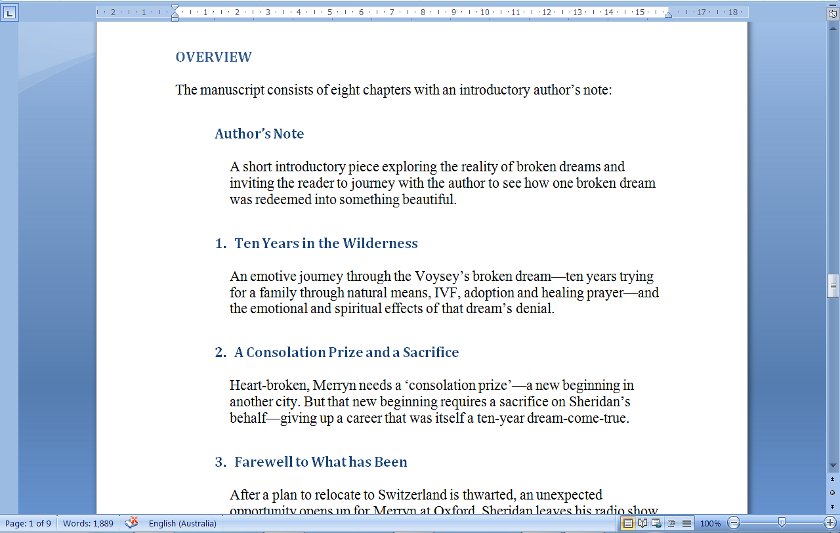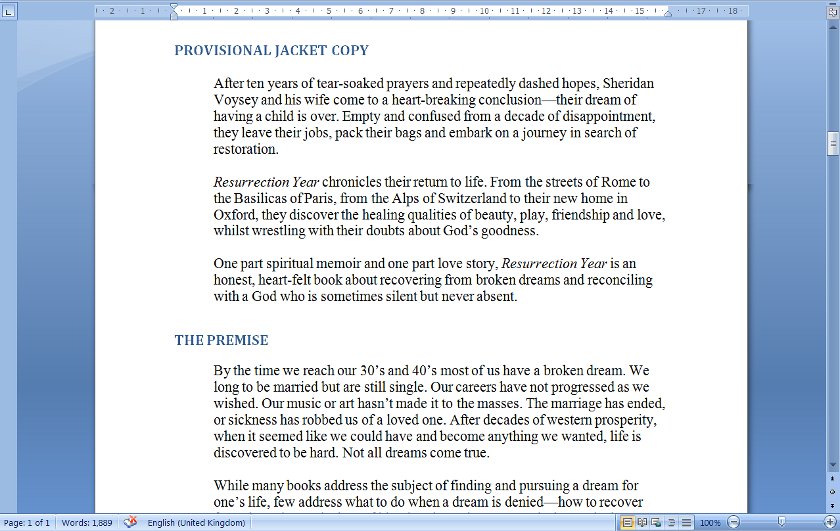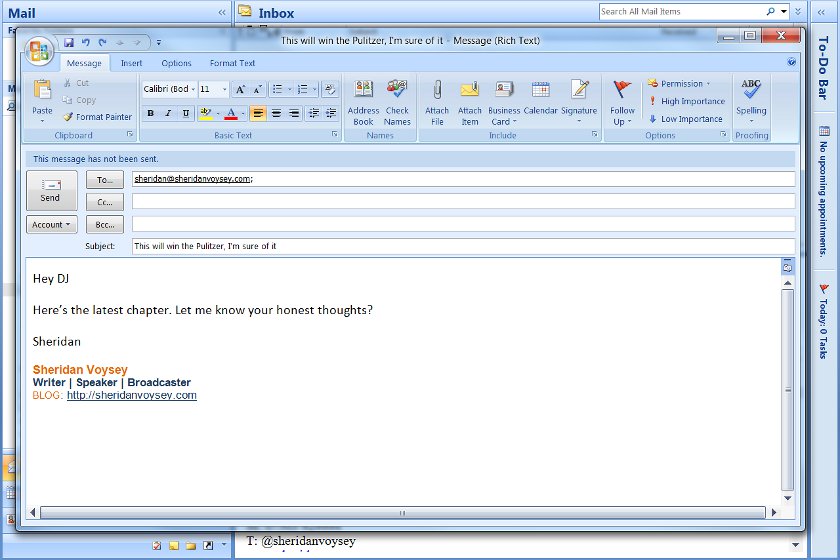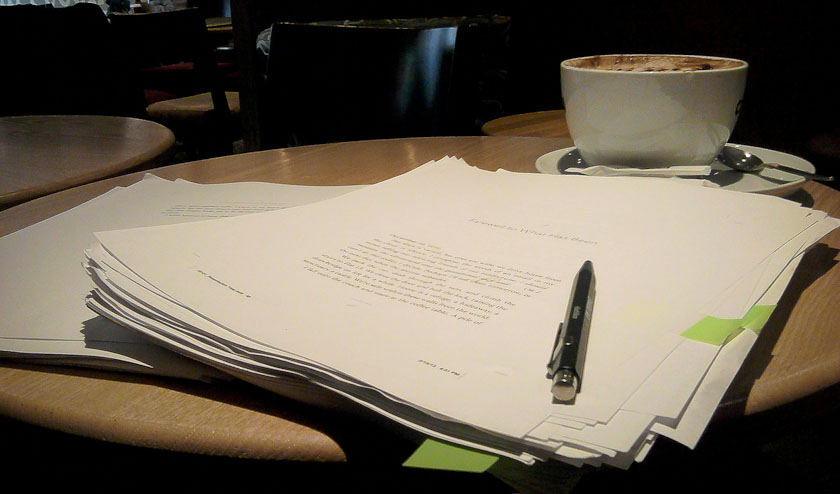How to Write a Book in 7 Simple Steps (My Highly Inefficient Process in Pictures)
Picture: Sheridan Voysey
So, you want to write a book. Great! Well-written books on important topics can change lives, if not the world. But where do you start? Well, dear budding author, here is a step-by-step guide on how to write a book. At least, this is how I do it. And on that note, I should add some caveats:
Caveat #1: There are ultimately more than 7 steps to writing a book (I’m not talking about landing a contract here, or finding readers for your work, which are important steps in themselves. Just writing the book)
Caveat #2: The steps aren’t always simple (sorry, but writing is hard work. However, these tips should help you move forward)
Caveat #3: My process is messy and highly inefficient (you may get better advice elsewhere. But hey, this has worked for me, and my advice is free)
Caveat #4: I’m talking nonfiction books here (although the steps will work for fiction too. It’s just not my area of expertise)
Right then. Ready?
Step 1: Keep a Journal
 Every article I write, talk I give, and book I release starts first in my journal. It’s my most important tool for capturing ideas, wrestling with big questions, brainstorming answers, recording insightful conversations, and following the deep movements of my soul – all valuable content for a writer. You can keep a digital journal if you wish, and I do you use tools like Evernote for collecting ideas too. But I find my best ideas and most honest revelation happens with pen and paper away from a computer screen.
Every article I write, talk I give, and book I release starts first in my journal. It’s my most important tool for capturing ideas, wrestling with big questions, brainstorming answers, recording insightful conversations, and following the deep movements of my soul – all valuable content for a writer. You can keep a digital journal if you wish, and I do you use tools like Evernote for collecting ideas too. But I find my best ideas and most honest revelation happens with pen and paper away from a computer screen.
 For instance, my book Resilient came about from an experiment reading the Sermon on the Mount everyday for a few months. I journaled my discoveries, those insights became articles, which later combined to become the book.
For instance, my book Resilient came about from an experiment reading the Sermon on the Mount everyday for a few months. I journaled my discoveries, those insights became articles, which later combined to become the book.
Step 2: Write Your Ideas and Stories on to a Single Note
 Once you have the big idea for your book (journaling can help you discover that too), re-read those journals to find relevant material, then transfer each insight or story on to a single note. I use cheap A5 notepads (you can use 4×5 cards too or, yes, mind map software if you really are a digital addict). Just write the key idea, a couple of points of description, and where to find it (I use the entry date as a reference. You could number your journals and include the number too).
Once you have the big idea for your book (journaling can help you discover that too), re-read those journals to find relevant material, then transfer each insight or story on to a single note. I use cheap A5 notepads (you can use 4×5 cards too or, yes, mind map software if you really are a digital addict). Just write the key idea, a couple of points of description, and where to find it (I use the entry date as a reference. You could number your journals and include the number too).
 For example, when I prepared to write Resurrection Year I re-read ten years of my journals to recapture the emotions, prayers, heartbreak, and discoveries of that harrowing decade. Given the topic of that book (starting again after a broken dream), this was no easy task. But I had the raw ingredients for the book within a fortnight.
For example, when I prepared to write Resurrection Year I re-read ten years of my journals to recapture the emotions, prayers, heartbreak, and discoveries of that harrowing decade. Given the topic of that book (starting again after a broken dream), this was no easy task. But I had the raw ingredients for the book within a fortnight.
Step 3: Group Those Notes into Chapters
 Next, rip all those cheap notepads into single pages (hint: pull the wire spiral from one end with pliers) and begin arranging your ideas into chapters. This is where the fun starts as you see your book starting to take form.
Next, rip all those cheap notepads into single pages (hint: pull the wire spiral from one end with pliers) and begin arranging your ideas into chapters. This is where the fun starts as you see your book starting to take form.
 Things can also get unwieldy here. When I did this for my current project I realised I was trying to cram too many ideas into too few chapters (above is the piles as they first were). I spent a couple of days working out a new structure and reassigned the notes. But that’s the beauty of the system – you simply move an idea to another pile when needed.
Things can also get unwieldy here. When I did this for my current project I realised I was trying to cram too many ideas into too few chapters (above is the piles as they first were). I spent a couple of days working out a new structure and reassigned the notes. But that’s the beauty of the system – you simply move an idea to another pile when needed.
 Once you’ve collated all those life-changing ideas into chapter stacks, clip ’em together. You’ve now got your chapters ready to write.
Once you’ve collated all those life-changing ideas into chapter stacks, clip ’em together. You’ve now got your chapters ready to write.
Step 4: Write An Overview
 Now it’s time to take those beautifully organised stacks and write an overview for your book. Some writers don’t work this way – they simply start where the inspiration is and write. But I’ve found doing three things up-front helps me profoundly:
Now it’s time to take those beautifully organised stacks and write an overview for your book. Some writers don’t work this way – they simply start where the inspiration is and write. But I’ve found doing three things up-front helps me profoundly:
- A chapter outline: write a paragraph on what you’ll cover in each chapter
- The premise: write a couple of paragraphs on what the book is about and why it’s needed
- The back cover copy: In two-to-three paragraphs I write the most inspiring description of the book I can. This becomes my ultimate quality goal

 As I said, not all writers do this. But a publisher will want to see the above when you pitch them, so why not do it now? And most importantly, these summaries will keep you on track as you face multiple decisions on what to include in your book, and not, as you write.
As I said, not all writers do this. But a publisher will want to see the above when you pitch them, so why not do it now? And most importantly, these summaries will keep you on track as you face multiple decisions on what to include in your book, and not, as you write.
Step 5: Write the Draft
 Now take a chapter stack and start weaving those beautiful ideas together! I know writers who use writer-specific software like Scrivener to do this, but good ol’ Microsoft Word is my basic tool. I write each day, then edit the following morning.
Now take a chapter stack and start weaving those beautiful ideas together! I know writers who use writer-specific software like Scrivener to do this, but good ol’ Microsoft Word is my basic tool. I write each day, then edit the following morning.
Step 6: Get Feedback
 As I complete a chapter, I send it to a group of 5-8 people I trust to give me honest feedback (choose people with specific expertise in your topic if needed, and some of them should be the kind of people you’re specifically writing the book for). I give this group complete freedom to tell me what they like, don’t like, or don’t understand about the book. If a few of them independently question something in the manuscript, I know what needs further work.
As I complete a chapter, I send it to a group of 5-8 people I trust to give me honest feedback (choose people with specific expertise in your topic if needed, and some of them should be the kind of people you’re specifically writing the book for). I give this group complete freedom to tell me what they like, don’t like, or don’t understand about the book. If a few of them independently question something in the manuscript, I know what needs further work.
Step 7: Edit (and Edit Again)
 One of the delights of completing each chapter for me is printing off the book to date, heading to a cafe, and reading the whole thing from start to finish. That way I get a feel for how the project is progressing in total. It’s here that I make even more edits to the manuscript.
One of the delights of completing each chapter for me is printing off the book to date, heading to a cafe, and reading the whole thing from start to finish. That way I get a feel for how the project is progressing in total. It’s here that I make even more edits to the manuscript.
(A note if you’re looking to self-publish: Please, please, get your book professionally edited. Find an editor with quality published books to their name and pay the money. Too many self-published books enter the world having needed serious additional work. They die a quick death.)
 And one day, after all that drafting and editing and rewriting and staring at the ceiling trying to work out how to say what you need to say, you will have the wonderful experience of completing a book and holding it in your hands. That leads to another journey itself, but I’ll save that for another time.
And one day, after all that drafting and editing and rewriting and staring at the ceiling trying to work out how to say what you need to say, you will have the wonderful experience of completing a book and holding it in your hands. That leads to another journey itself, but I’ll save that for another time.
***
Learn More
- Audio: How to Write Your Memoir (a seminar I gave on giving your personal story universal appeal)
- Audio: A Basket Full of Stars (a seminar on creativity)
- Book: Putting Your Passion into Print by Eckstut and Sterry (a little outdated but helpful on the business of getting published)
- Book: Bird By Bird by Anne Lamott (a humorous guide to the writing life)
- Book: On Writing by Steven King (I haven’t read it but friends rave about it)
- Link: Jerry B Jenkins has a good, substantial post on writing a book
- Link: Self-Publishing School has an excellent post reviewing the essentials of book writing too
Talk to Me
Got a question, or some helpful tip on writing to share? Leave a comment below now or call me using the ‘Send Voicemail’ button on the right.






Jenny B
Hi Sheridan, Thanks so much for this post. Whilst I’m not sure that I’ll ever write a book your method appeals to how I like to organize my thoughts, learnings etc. I think it would be a great help in preparing talks too – Thanks heaps.
Sheridan Voysey
Yes, the same process can apply to organising any crafted message. Thanks Jenny.
Tanya Marlow
You have such great clarity of thought! I’m finding there’s lots to learn from your process. I think I need to journal more – but I don’t know if my energy allowance will let me. Tricky. Fun to see it all on paper!
Sheridan Voysey
I hear you’re the Scrivener queen, Tanya, so don’t go changing anything too quickly :). But definitely journal when you can.
Tanya Marlow
I do so like being given the title of Scrivener queen, and I await my coronation with eagerness. But I have learnt recently the importance of writing it while it’s still present. I’m having a chapter published in a book by IVP this year. I wrote it c. 3 years ago about a time in my life that was c. 5 years ago. I was really shocked re-reading it – I’d forgotten that time of my life was so hard. My memory had softened the recollection. That’s the value of recording it immediately, isn’t it? Argh. Maybe I should leave voice memo? URGH. But no – can you imagine trawling through them?? I’ll keep thinking on it
Sheridan Voysey
Voice to text? That could be a good option for you. The old program was DragonEdit but there will be better ones out there now
Andrew
That’s really good, Sheridan! Thanks.
But now that we know how to write a book, how do you then get a book published??
Sheridan Voysey
Thanks Andy. There is so much online about getting published, either going the traditional route or self-publishing. The book I mention above, Putting Your Passion into Print, is still an excellent primer on that.